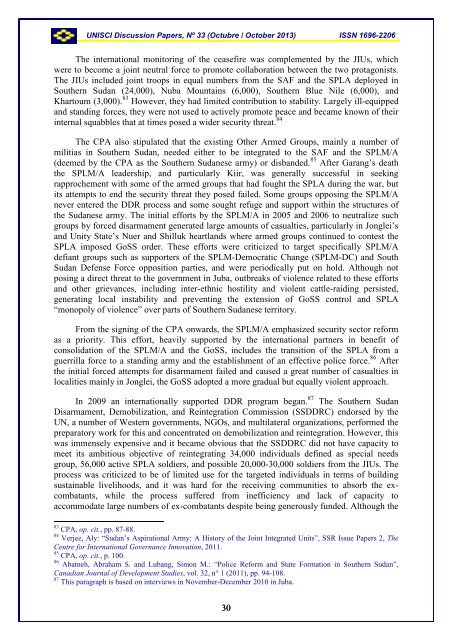UNISCI - Universidad Complutense de Madrid
UNISCI - Universidad Complutense de Madrid
UNISCI - Universidad Complutense de Madrid
Create successful ePaper yourself
Turn your PDF publications into a flip-book with our unique Google optimized e-Paper software.
<strong>UNISCI</strong> Discussion Papers, Nº 33 (Octubre / October 2013) ISSN 1696-2206The international monitoring of the ceasefire was complemented by the JIUs, whichwere to become a joint neutral force to promote collaboration between the two protagonists.The JIUs inclu<strong>de</strong>d joint troops in equal numbers from the SAF and the SPLA <strong>de</strong>ployed inSouthern Sudan (24,000), Nuba Mountains (6,000), Southern Blue Nile (6,000), andKhartoum (3,000). 83 However, they had limited contribution to stability. Largely ill-equippedand standing forces, they were not used to actively promote peace and became known of theirinternal squabbles that at times posed a wi<strong>de</strong>r security threat. 84The CPA also stipulated that the existing Other Armed Groups, mainly a number ofmilitias in Southern Sudan, nee<strong>de</strong>d either to be integrated to the SAF and the SPLM/A(<strong>de</strong>emed by the CPA as the Southern Sudanese army) or disban<strong>de</strong>d. 85 After Garang’s <strong>de</strong>aththe SPLM/A lea<strong>de</strong>rship, and particularly Kiir, was generally successful in seekingrapprochement with some of the armed groups that had fought the SPLA during the war, butits attempts to end the security threat they posed failed. Some groups opposing the SPLM/Anever entered the DDR process and some sought refuge and support within the structures ofthe Sudanese army. The initial efforts by the SPLM/A in 2005 and 2006 to neutralize suchgroups by forced disarmament generated large amounts of casualties, particularly in Jonglei’sand Unity State’s Nuer and Shilluk heartlands where armed groups continued to contest theSPLA imposed GoSS or<strong>de</strong>r. These efforts were criticized to target specifically SPLM/A<strong>de</strong>fiant groups such as supporters of the SPLM-Democratic Change (SPLM-DC) and SouthSudan Defense Force opposition parties, and were periodically put on hold. Although notposing a direct threat to the government in Juba, outbreaks of violence related to these effortsand other grievances, including inter-ethnic hostility and violent cattle-raiding persisted,generating local instability and preventing the extension of GoSS control and SPLA“monopoly of violence” over parts of Southern Sudanese territory.From the signing of the CPA onwards, the SPLM/A emphasized security sector reformas a priority. This effort, heavily supported by the international partners in benefit ofconsolidation of the SPLM/A and the GoSS, inclu<strong>de</strong>s the transition of the SPLA from aguerrilla force to a standing army and the establishment of an effective police force. 86 Afterthe initial forced attempts for disarmament failed and caused a great number of casualties inlocalities mainly in Jonglei, the GoSS adopted a more gradual but equally violent approach.In 2009 an internationally supported DDR program began. 87 The Southern SudanDisarmament, Demobilization, and Reintegration Commission (SSDDRC) endorsed by theUN, a number of Western governments, NGOs, and multilateral organizations, performed thepreparatory work for this and concentrated on <strong>de</strong>mobilization and reintegration. However, thiswas immensely expensive and it became obvious that the SSDDRC did not have capacity tomeet its ambitious objective of reintegrating 34,000 individuals <strong>de</strong>fined as special needsgroup, 56,000 active SPLA soldiers, and possible 20,000-30,000 soldiers from the JIUs. Theprocess was criticized to be of limited use for the targeted individuals in terms of buildingsustainable livelihoods, and it was hard for the receiving communities to absorb the excombatants,while the process suffered from inefficiency and lack of capacity toaccommodate large numbers of ex-combatants <strong>de</strong>spite being generously fun<strong>de</strong>d. Although the83 CPA, op. cit., pp. 87-88.84 Verjee, Aly: “Sudan’s Aspirational Army: A History of the Joint Integrated Units”, SSR Issue Papers 2, TheCentre for International Governance Innovation, 2011.85 CPA, op. cit., p. 100.86 Abatneh, Abraham S. and Lubang, Simon M.: “Police Reform and State Formation in Southern Sudan”,Canadian Journal of Development Studies, vol. 32, n° 1 (2011), pp. 94-108.87 This paragraph is based on interviews in November-December 2010 in Juba.30
















